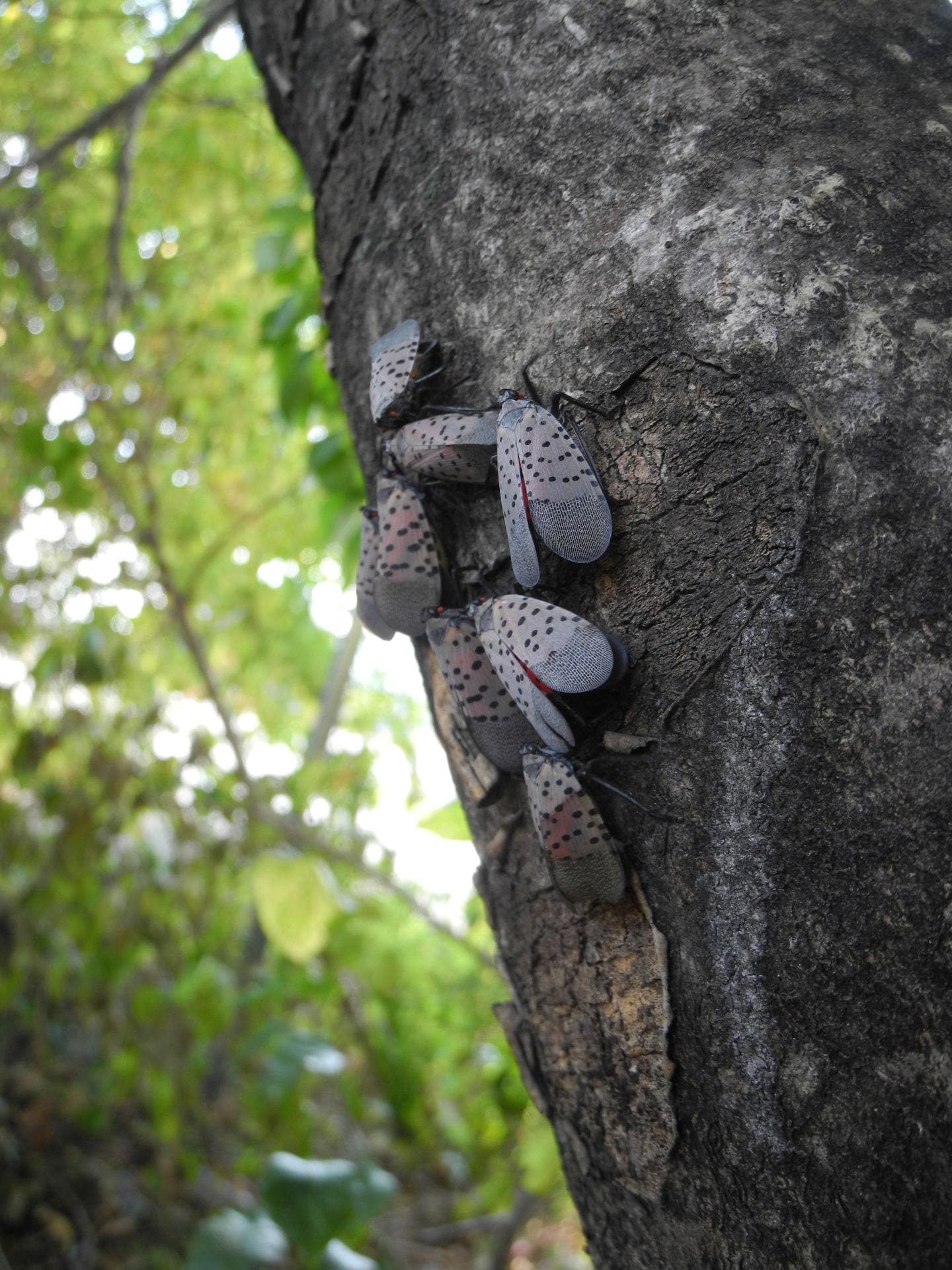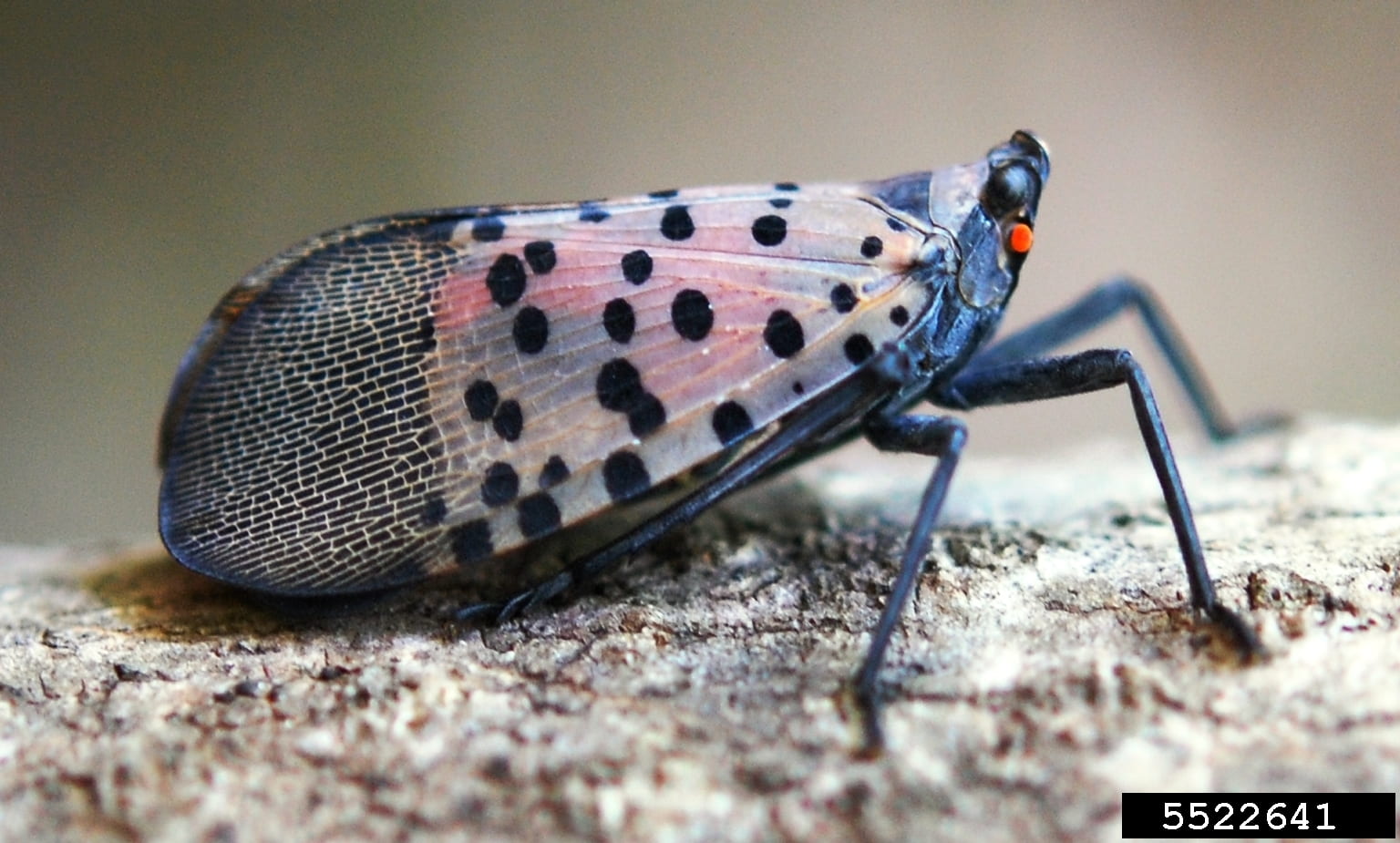The NYSIPM program, along with the Department of Agriculture and Markets, and the Department of Environmental Conservation have been monitoring for Spotted Lanternfly since its first occurrence in PA in 2014. In preparation, we developed educational resources for New Yorkers. Partnering with affected states, we’ve maintained a map tracking its spread and quarantines across the mid-Atlantic and Northeast region.

Now, as of August 14, 2020 has confirmed a living population of spotted lanternfly on Staten Island. Because pests don’t care about borders, experts anticipated this introduction into the state and put in place the groundwork needed to keep ahead of this invasive.
Knowledge and experience from Pennsylvania’s spotted lanternfly specialists continues to benefit Cornell extension and research staff. Pennsylvania agriculture experienced grapevine deaths in some vineyards, and their economists estimate a potential combined annual loss to their state of $324 million and 1,665 jobs. Because of SLF’s ability to be a significant agricultural pest, research is underway even now, as Cornell researches biological and other control options.

The spotted lanternfly is not a fly, but a large planthopper. Adults are about an inch long. They do not bite or sting, and are not a threat to people, pets or livestock. For most New Yorkers, it will be no more than a nuisance pest. Nymphal and adult spotted lanternflies have piercing-sucking mouthparts that drill into plant phloem. SLF’s excrement—a sappy liquid called honeydew—makes things sticky and becomes the breeding ground for sooty mold, an annoying black fungal growth that is not toxic and does not kill plants. If necessary, wash honeydew and sooty mold off of your outdoor belongings, and move them out from under trees that have hosted the SLF. Note: honeydew can also draw ants and yellow jacket wasps.
Spotted lanternfly’s favorite host is another invasive species, the Tree of Heaven, but they also feed on many other trees and plants (see our list). Unfortunately, this includes cultivated grapevine. With New York state’s important wine production and grape growing regions from Long Island to Western NY, we are particularly concerned about this pest’s impact.
To properly identify spotted lanternfly and understand its life cycle, host plants, and how to monitor and manage it, visit our resources here.
“What should I do?”
1) If you think you see a spotted lanternfly, use the new reporting form found here: https://survey123.arcgis.com/share/a08d60f6522043f5bd04229e00acdd63
2) Educate yourself. It is likely that spotted lanternfly will continue to spread north through New York and New England. Check out the lanternfly life cycle here so you’ll know what to look for. From fall through spring, look for egg masses. (See: how to destroy egg masses). In late spring and early summer look for the nymph stages; in late summer through fall, look for adults.

3) Don’t transport this pest. Individual and commercial travelers alike should be aware that there’s the potential to spread this insect to new areas without knowing it. Adult spotted lanternfly can end up in vehicles. Egg masses can be laid on virtually anything, and can be overlooked. Inspect anything that you load into your vehicle. Checklist here: https://nysipm.cornell.edu/sites/nysipm.cornell.edu/files/shared/documents/SLF-checklist.pdf
4) Keep up with the latest news on the spread of Spotted Lanternfly and other pest management concerns by following this and other NYSIPM program blogs, Facebook page, Twitter account and Instagram.
For Immediate Release: August 14, 2020
State Agencies Encourage Public to Report Findings of Invasive Pest
The New York State Departments of Agriculture and Markets (AGM), Environmental Conservation (DEC), and Office of Parks, Recreation and Historic Preservation (OPRHP) today confirmed that Spotted Lanternfly (SLF), an invasive pest from Asia, has been found on Staten Island. Several live, adult insects were discovered by OPRHP staff in Clay Pit Ponds State Park Preserve. SLF (see photo below) is a destructive pest that feeds on more than 70 plant species, including tree-of-heaven, and plants and crops that are critical to New York’s agricultural economy, such as maple trees, apple trees, grapevine, and hops.
State Agriculture Commissioner Richard A. Ball said, “The Department is working closely with its partners at the Department of Environmental Conservation, the State Office of Parks, Recreation and Historic Preservation, and the U.S. Department of Agriculture (USDA) to mitigate the impacts of this destructive pest, which can weaken plants and have a devastating impact on agriculture. While this find on Staten Island is concerning, New York State has taken strong actions to combat the establishment of SLF since 2017. We will continue our work to survey and inspect high-risk areas and implement targeted management plans. We also urge the public to be vigilant and report any suspected sightings of SLF to help slow the spread of this invasive.”
DEC Commissioner Basil Seggos said, “Since Spotted Lanternfly was first discovered in neighboring states, DEC has worked aggressively with the State Department of Agriculture and Markets, Office of Parks, Recreation and Historic Preservation, USDA and other partners to educate New Yorkers and take steps to prevent this invasive species from establishing itself in New York State. This invasive pest has the potential to severely impact and stress New York’s forests, agricultural crops, and tourism industries. The first live find on Staten Island is concerning, but our goal remains to find Spotted Lanternfly early and prevent it from further entering New York State and limiting any serious threats to our natural resources.”
State Parks Commissioner Erik Kulleseid said, “Spotted Lanternfly poses a troubling threat to the environment and agriculture of New York State but also to the quality of recreational opportunities and experiences we offer in our State Parks and public lands. I applaud our Parks’ environmental stewardship staff for identifying this pest, so New York State can quickly begin taking steps to slow its spread. Park visitors across the state can help in identifying and reporting this destructive pest, and I urge them to familiarize themselves with its signs.”
Following the finding by OPRHP, AGM, working with DEC, OPRHP, and the USDA, immediately began extensive surveys throughout the area. Crews will continue to survey areas on Staten Island, develop management plans to slow SLF’s spread, and minimize the damage and impact from this invasive species.
AGM urges New Yorkers to report potential sightings using the web reporting tool found here: https://survey123.arcgis.com/share/a08d60f6522043f5bd04229e00acdd63
SLF feedings can stress plants, making them vulnerable to disease and attacks from other insects. SLF also excretes large amounts of sticky “honeydew,” which attracts sooty molds that interfere with plant photosynthesis, negatively affecting the growth and fruit yield of plants, and impacting forest health. SLF also has the potential to significantly hinder quality of life and recreational activities due to the honeydew and the swarms of insects it attracts.
First discovered in Pennsylvania in 2014, SLF has since been found in New Jersey, Maryland, Delaware, West Virginia and Virginia. Given the proximity to the Pennsylvania and New Jersey infestations, New York State is at high risk for infestation.
Since 2017, AGM, DEC, and OPRHP have taken an aggressive approach to keeping SLF from establishing in New York State, conducting surveys of high-risk areas across the State; inspecting nursery stock, stone shipments, and commercial transports from quarantine areas; and launching a comprehensive education and outreach campaign to enlist the public’s help in reporting SLF.
While these insects can jump and fly short distances, they spread primarily through human activity. SLF can lay their eggs on any number of surfaces, such as vehicles, stone, rusty metal, outdoor furniture, and firewood. Adult SLF can hitch rides in vehicles, on any outdoor item, or cling to clothing or hats, and be easily transported into and throughout New York.
The public is encouraged to thoroughly inspect vehicles, luggage and gear, and all outdoor items for egg masses and adult SLF before leaving areas with SLF, particularly in the counties of states in the quarantine area—Pennsylvania, New Jersey, Maryland, Delaware, West Virginia and Virginia. If SLF adults are found, residents should remove them and scrape off all egg masses.
Residents can also help by allowing surveyors access to properties where SLF may be present. Surveyors will be uniformed and will always provide identification.
Identifying SLF
Adult SLF are active from July to December. They are approximately one-inch long and half an inch wide at rest, with eye-catching wings. Adults begin laying eggs in September. Signs of an SLF infestation may include:
- Sap oozing or weeping from open wounds on tree trunks, which appear wet and give off fermented odors.
- One-inch-long egg masses that are brownish-gray, waxy and mud-like when new. Old egg masses are brown and scaly.
- Massive honeydew build-up under plants, sometimes with black sooty mold developing.
For more information on Spotted Lanternfly, visit https://agriculture.ny.gov/spottedlanternfly.

